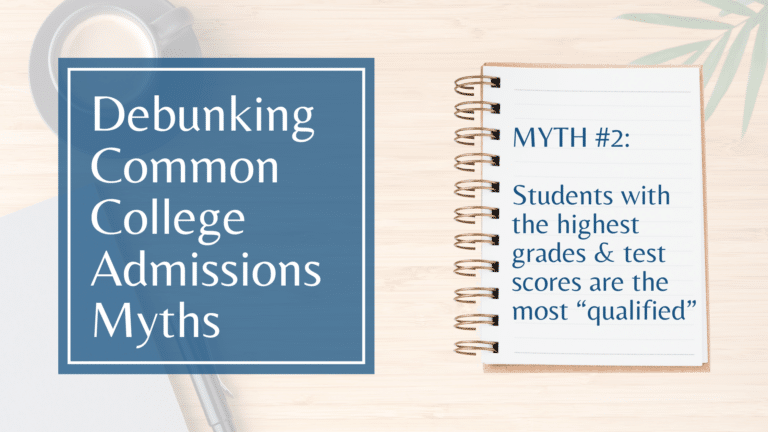Join Our Email List
Get the latest admissions tips and
announcements right in your inbox!
announcements right in your inbox!
We respect your privacy. Unsubscribe at any time.

The college admissions process is a black box. Try as we might, it’s impossible to definitively determine why any individual student does or does not get into a particular school during any given admissions cycle. To satisfy our innate desire for logical explanations, we tend to focus on measurable metrics, such as average test score and GPA ranges of a college’s admitted students or incoming class. We naturally assume that students whose numbers fall within range are “qualified” and that students whose numbers are higher than others’ are “more qualified.” Each year, flabbergasted students and parents inevitably circulate stories about applicants getting into X or Y college with lower numbers than the class valedictorian who was not admitted despite having perfect grades and test scores.
Using academic metrics as a measure of qualifications is understandable. These statistics are visible, quantifiable, and comparable. However, average GPA and test score ranges merely reflect the academic stats of the incoming class; they are neither definitive requirements nor absolute benchmarks. Plenty of students who have numbers within (or above) range are not admitted while students whose numbers are below range are offered spots. Moreover, a sample size limited to anecdotes about friends, acquaintances, and people referenced on online forums is statistically insignificant. Even if the academic stats cited in hearsay reports are accurate, they certainly do not provide a complete picture of an applicant’s merit.
Despite the disproportionate amount of attention GPAs and test scores receive because of their visibility, they are just two of many factors that weigh into admissions decisions. Duke University’s longtime Dean of Admissions Christoph Guttentag contextualized academic statistics while welcoming the university’s Class of 2022 to campus. He said, “I’d like to talk a little about how you were chosen. And, this might surprise you, but your academic credentials actually had little to do with it. Once we saw that you were one of the bright ones…at that point, whether your grades and test scores were a little better or a little worse than someone else’s really didn’t matter.” Dean Guttentag went on to explain the factors that “did make a difference”: (1) “You knew what to do when an opportunity presented itself…”; (2) “You found a way to make something better…”; (3) “You were reflective and open”; (4) “You were kind and you were supportive and you were a good friend…” and (5) “You weren’t perfect…Perfect is kind of boring. Imperfect and striving is a lot more interesting.”
While Dean Guttentag’s comments will hopefully alleviate some of the pressure applicants feel to be “perfect,” he delineates criteria that are difficult to assess. Unlike test scores or GPAs, qualities such as kindness and seizing opportunities are not easily measurable for any individual student, much less in the context of the entire applicant pool. This is the task undertaken by admissions officers, who examine each student’s application holistically in an effort to build and shape a diverse incoming class of students with varied interests, backgrounds, and experiences. Diversity enables colleges to create a dynamic, robust atmosphere in which students are exposed to new ideas, an outcome that may be elusive if the school primarily admitted students who, say, hail from suburbs in the Northeast, want to major in Psychology, and play a sport in high school.
Shielded from this closed-door process, applicants are not privy to the qualifications of their peers or the institutional priorities that often drive admissions decisions. These priorities, which can vary from school to school and year to year, include preferences for geographic or socioeconomic diversity, gender parity, athletic or performing arts talent, legacy status, yield protection (admitting students who will attend), etc. While non-quantifiable factors and institutional priorities are equally (if not more) important than academic metrics, they get far less air time because they are less visible and harder to gauge.
Essentially, the determination of what makes an applicant “qualified” is up to each individual college based on its specific objectives in any particular admissions cycle. The mere fact that a student is academically capable of succeeding at an institution, without more, is insufficient to warrant admission. The reality is that selective colleges could fill their classes multiple times over with valedictorians and A students who are academically capable of handling the college workload. However, with more than 20,000 high schools in the U.S. alone (many with multiple valedictorians and salutatorians) and well-documented grade inflation, applicant pools are teeming with high stats students. Academic metrics do matter, but they are not be-all and end-all determinants of who is qualified or who gets in. High numbers will put students into consideration, but the intangibles are often what ultimately tip the scales in admissions decisions.
